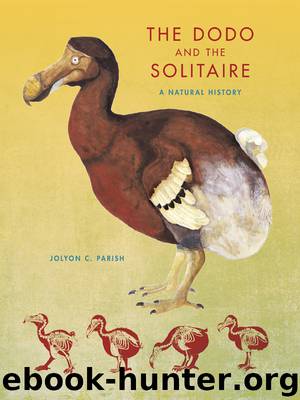The Dodo and the Solitaire by Jolyon C. Parish

Author:Jolyon C. Parish
Language: eng
Format: epub
Publisher: Indiana University Press
After dinner it was arranged that we should start in boats at midnight, the tide then serving, for the caves on the south-west side of the island. We eventually got off about one o'clock in the morning of the 2nd November. The police magistrate took Captain [Archibald] Anson, myself, and three others in his whale-boat. The Captain of the “Rapid” took in his Captain Barkly,[67] and two more of the party…. About eleven o'clock we started for another cave, about two miles [3.2 km] off [from the first cave, which was about quarter of a mile (0.4 km) inland from their landing site]…. Arrived at the cave, it was found to be too late to enter, for fear of losing the tide. All my companions turned back at once, excepting one who went some hundred yards or so inside with me. I picked up a shell or two of a land-tortoise, and two bones; one of which [UMZC 633] on examination I find nearly fits the representation of the left tarsometatarsus in Mr. Strickland's work (plate 15. fig. 2), with the exception that it is as perfect as the right one depicted on the same plate (fig. 3). The other bone is a fragment [of a left humerus], of which both extremities are wanting. Both are almost free from any earthy deposit upon them, and indeed where I found them there appeared to be no drip at all. In one of the cavities of the tarsometatarsus there is just a small quantity of white matter–lime, I suppose, in one of its forms, but it comes off easily enough. They are of an ivory-yellow–almost, I should say, their natural colour.[68]
Since my return to Mauritius, I have found that Captain Barkly, when in Rodriguez, picked up a third bone [UMZC 632], which at first he thought was only a turtle's; but it turns out to be an undoubted right femur of a bird, and similar to the specimen from the Paris Museum figured in “The Dodo” book (plate 14, fig. 8).[69] (E. Newton 1865, 150–153)
Unfortunately, Newton had no digging tools and, moreover, had to depart back to Mauritius the following day, so no further searches could be conducted at that time. The three bones were sent to England and exhibited by Alfred Newton on February 14 at the ZSL; they were subsequently described under the nomen Didus nazarenus (Newton 1865a; see fig. 5.40).
Edward Newton sponsored excavations of the Rodrigues caves in the 1860s and 1870s (Cheke 2004b). He persuaded George Jenner, resident magistrate of the island, to search for further remains in the caves visited the previous year. The result was that, in 1865, 85 more bones, belonging to at least 16 individuals, were discovered in the caves of Plaine Corail (Newton 1865b); these remains were sent by Jenner and reached Edward Newton in Mauritius on August 1, 1865. While attending the meeting of the BAAS at Birmingham in early September 1865, Alfred Newton received a letter from his brother, Edward, dated
Download
This site does not store any files on its server. We only index and link to content provided by other sites. Please contact the content providers to delete copyright contents if any and email us, we'll remove relevant links or contents immediately.
| Amphibians | Animal Behavior & Communication |
| Animal Psychology | Ichthyology |
| Invertebrates | Mammals |
| Ornithology | Primatology |
| Reptiles |
Sapiens: A Brief History of Humankind by Yuval Noah Harari(13038)
The Tidewater Tales by John Barth(12026)
Do No Harm Stories of Life, Death and Brain Surgery by Henry Marsh(6332)
Mastermind: How to Think Like Sherlock Holmes by Maria Konnikova(6225)
The Thirst by Nesbo Jo(5778)
Why We Sleep: Unlocking the Power of Sleep and Dreams by Matthew Walker(5637)
Sapiens by Yuval Noah Harari(4529)
Life 3.0: Being Human in the Age of Artificial Intelligence by Tegmark Max(4492)
The Longevity Diet by Valter Longo(4444)
The Rules Do Not Apply by Ariel Levy(3897)
The Immortal Life of Henrietta Lacks by Rebecca Skloot(3820)
The Body: A Guide for Occupants by Bill Bryson(3789)
Why We Sleep by Matthew Walker(3767)
Animal Frequency by Melissa Alvarez(3750)
Yoga Anatomy by Kaminoff Leslie(3696)
Barron's AP Biology by Goldberg M.S. Deborah T(3628)
The Hacking of the American Mind by Robert H. Lustig(3575)
All Creatures Great and Small by James Herriot(3506)
Yoga Anatomy by Leslie Kaminoff & Amy Matthews(3392)
